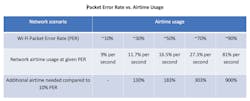Good Wi-Fi Connectivity is Essential for IoT Product Success
Internet of Things (IoT) momentum is bringing connectivity to devices we never thought would ever be connected. Now you can prepare your coffee without walking to your coffeemaker. You simply send a command to the maker using your phone. It even learns your preferences and prepares your coffee the way you like, every time.
The number of connected devices and users continues to increase rapidly. And that’s great! But, for a sustainable IoT infrastructure, it’s necessary that an IoT device performs well in every environment. An IoT device that can’t connect to the local access point (AP) is useless. System designers need to understand various Wi-Fi parameters such as transmit power, receive sensitivity, coexistence, and throughput while designing an IoT product. This article covers some of the important aspects that are essential for a successful IoT product.
2.4 GHz is a Crowd
Today, the most commonly used wireless technologies used in IoT devices are Wi-Fi and Bluetooth that utilize the 2.4-GHz spectrum. Not only is Wi-Fi implemented by IoT devices, but it’s extensively used in every home for televisions, laptops, tablets, and mobile phones. The 2.4-GHz spectrum has become like a conference room where several people are all trying to have a conversation at the same time. For a conversation to be understood, though, only one device can talk at one time.
Now imagine a device that can’t communicate efficiently and tries to talk continuously. No one else can talk, so no meaningful conversations can take place anywhere in the room. There’s little in the Wi-Fi spec that emphasizes performance and spectrum utilization. With the increasing density of Wi-Fi devices, the Wi-Fi Alliance needs to add stringent requirements for good performance on top of adherence to the protocol to pass the certification process.
IoT device manufacturers need to get over the low-cost-only approach to make sure they’re not designing Wi-Fi connected devices that are bad performers and bad neighbors for other Wi-Fi devices. Just one bad device is enough to bring down the customer’s entire Wi-Fi network.
For a future-proof IoT network, it’s important that system designers use robust Wi-Fi connectivity. It’s of the utmost important for companies to understand the consequences of bad design as it directly relates to the product’s success and the brand’s reputation. An IoT product that’s unable to connect to the AP is useless for the customer.
When customers face any issues with connectivity, they are likely to return the product or write a bad online review. These contribute to unsuccessful product and negative impact on brand name. Even with a well-designed product, it is necessary to provide extensive technical support for customers who are new to IoT.
The following are the key symptoms of bad Wi-Fi connectivity:
- Poor range
- Low throughput
- High packet error rate
- Bad coexistence
Poor Range
Poor range limits the distance at which your IoT product can connect to the AP. This is the very first experience your customer has with your product. If it doesn’t even connect, in most cases the customer will return the product and slam a bad review. Your IoT product may not be able to connect to the AP at a distance because of low transmit power, poor sensitivity, or lack of transmit beamforming support.
A Wi-Fi link requires two devices to exchange packets to establish a connection. The distance at which a device can connect to the AP is determined by factors listed below.
Transmit power
The transmit power of IoT devices impacts the ability of the AP to hear it. Beyond a certain level, the output of Wi-Fi’s power amplifier starts to distort. To deal with this, most Wi-Fi devices limit Tx power. For instance, Cypress’ Wi-Fi devices use proprietary methods to deal with this distortion and provide higher Tx power. Another challenge with Tx power is regulatory limitations imposed by different countries. This means that the maximum Tx power needs to be controlled based on the country to avoid regulatory violations. As a result, the Wi-Fi subsystem must provide an easy or automated method to control the transmit power so that the IoT device can transmit at the maximum Tx power level while avoiding any regulatory (FCC, CE, etc.) violations.
Receive sensitivity
Receive sensitivity is the device’s capability to hear the AP. Good receive sensitivity in conjunction with good transmit power is the key to good range. Some Wi-Fi devices include algorithms that can process inputs with smaller signal-to-noise ratio than others. Thus, the receive sensitivity specification needs to be considered while selecting a device for an IoT product.
Link budget
The link budget can have a significant impact on range.
Transmit power, receive sensitivity, and environmental factors define the link budget between two Wi-Fi devices. Suppose one device has +3 dBm more Tx power than the other and −3 dBm better sensitivity. This results in a 6-dBm link budget improvement. Every 6-dBm increase in the link budget doubles the range (see figure).
Transmit beamforming
Transmit beamforming focuses transmit power in a given direction—it helps increase the range in that direction. For instance, if an IoT device supports transmit beamforming, it can connect to the AP at a longer distance. However, not all Wi-Fi devices support transmit beamforming. Beamforming was first introduced in 802.11n. However, its implementation was left to the vendors. This has made interoperability a challenge. In 802.11ac, this feature was well-defined in WLAN specification and allowed implementations that were interoperable. Considering this fact, 11ac becomes a necessity to increase range without requiring repeaters.
Low Throughput
Low throughput has a severe impact on performance, including:
• Latency: The lower the throughput, the higher the latency. Though most IoT devices require only a few bytes of data to be sent, higher latency can result in a poor user experience. Low latency also means reduced reliability in time-critical applications using sensors such as medical and industrial devices.
• Battery life: If the throughput/modulation index is low, the device takes longer to transmit and, hence, has longer active times. That directly translates into short battery life.
• Poor spectrum utilization: Low throughput increases the airtime needed for communication. This directly results in making the 2.4-GHz spectrum even more congested.
A device’s throughput is impacted by several factors such as link budget, modulation index, and spectrum availability. Wi-Fi devices adjust their link data rate to accommodate the link budget. A higher modulation index means higher throughput. Higher modulation index support requires improved signal conditioning. So, some devices perform better at a lower modulation index versus a higher modulation index. Good sensitivity and good Tx power across various modulation and coding schemes translates into a good rate versus range.
For good throughput, it’s important to investigate the device’s throughput at all supported modulation index and coding schemes. Also, it’s important to pick a device that supports a higher modulation index. 802.11ac supports 256-QAM (quadrature amplitude modulation) that enables higher throughput in 802.11ac devices compared to 64-QAM supported by 802.11n.
The number of devices trying to communicate in a given area also directly affects throughput. The more devices, the less time there is for each device to send/receive data. This limits the effective throughput. The problem becomes severe in the 2.4-GHz band, where most legacy Wi-Fi devices are trying to communicate along with other wireless devices such as Bluetooth and Zigbee. So, along with higher modulation index to improve throughput, 802.11ac’s support for the less-crowded frequency band—5 GHz—also helps in improving throughput.
High Packet Error Rate
In Wi-Fi, whenever there’s a packet error, it needs to be resent. A device with a high packet error rate (PER) causes all devices to perform poorly in the network because it takes longer to transmit a packet successfully. It potentially increases the number of collisions, thus requiring other devices to retransmit as well, which further impacts PER. The table shows the airtime usage based on different PER. It reveals the percentage of airtime per second that will be taken to transmit 1000 bytes of data by 20 nodes transmitting one packet per second.
Looking at the table, a device with a 90% error rate takes about 900% of the airtime compared to a device that has 10% PER. High PER also increases the latency; the packet needs to be retransmitted if there’s a packet error. It becomes a challenge in time-critical applications. Therefore, it’s important to understand the Wi-Fi device’s PER before selecting it for an IoT application. 802.11ac can be very useful—it supports the 5-GHz band, which is less congested and results in fewer packet collisions.
Bad Coexistence
IoT devices often require Wi-Fi and Bluetooth wireless technologies to be co-located. The challenge is that they operate in the same frequency band, so if they’re not coordinated, they can clobber each other. Bad coexistence means Wi-Fi throughput suffers significantly.
There are several coexistence schemes, and their performance varies significantly. It takes hundreds of man-years to create a coexistence algorithm that makes real-time decisions in granting medium access to Wi-Fi and Bluetooth. RF chains of Wi-Fi and Bluetooth radios must be optimally controlled to minimize the interference and maximize the performance. A good arbiter needs a lot of information from both Wi-Fi and Bluetooth core to implement coexistence.
Some Wi-Fi and Bluetooth combo devices come with integrated coexistence, which allows an arbiter to communicate with the Wi-Fi and Bluetooth cores over a parallel bus. 5-GHz support for Wi-Fi in 802.11n and 802.11ac is very useful in applications that require both Wi-Fi and Bluetooth to operate at the same time. So, in addition to good coexistence mechanism, a device with 5 GHz should be used for the best coexistence.
Good Wi-Fi connectivity is the backbone of a successful IoT product. It’s important to select a device that has a good range, high throughput, low PER, and good coexistence support. 802.11ac helps in increasing range by means of transmit beamforming, higher throughput due to improved modulation index, and low PER and coexistence due to support for the less-congested 5-GHz band. Combo devices with proven coexistence can provide significantly better Wi-Fi throughput even in the presence of Bluetooth. All of these factors should be considered when selecting a connectivity solution for an IoT product.
Sachin Gupta is a Staff Product Marketing Engineer in the IoT business unit with Cypress Semiconductor.
About the Author
Sachin Gupta
Staff Product Marketing Engineer
Sachin Gupta is a Staff Product Marketing Engineer in the IoT business unit with Cypress Semiconductor. He holds a Bachelor’s degree in Electronics and Communications from Guru Gobind Singh Indraprastha University. He has nine years of experience in SoC application development and product marketing.



